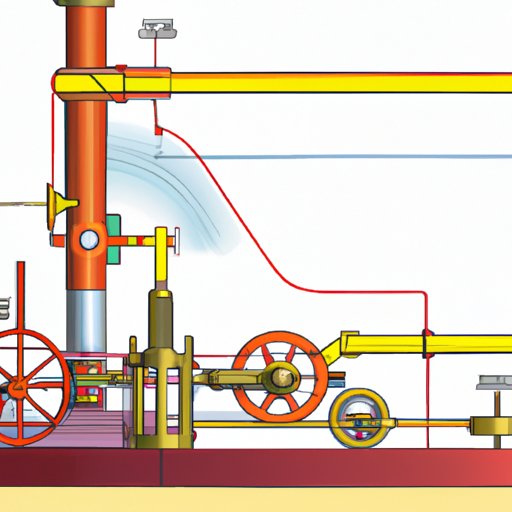Introduction
A steam engine is a device that uses heat energy to produce mechanical power. It was invented in the late 18th century by British inventor James Watt and has since been used in a variety of applications, from powering locomotives to generating electricity. The steam engine is an integral part of the Industrial Revolution and its development has helped shape modern society.
The basic principle behind a steam engine is simple: heat energy is converted into mechanical energy by the expansion of steam. This conversion process is known as thermodynamics, and it is the basis for how a steam engine works. In this article, we will explore the history and development of steam engines, the components and operation of a steam engine, the different types of steam engines, and the step-by-step guide to understanding the mechanics of a steam engine.
Components and Operation
A steam engine is made up of several components, including a boiler, a cylinder, a piston, and a valve. The boiler is responsible for heating water and creating steam, which is then fed into the cylinder. The piston in the cylinder moves up and down as the steam expands and contracts. The valve controls the flow of steam into and out of the cylinder, allowing for the efficient transfer of energy.
To explain the operation of a steam engine, it is helpful to look at the physics behind it. According to the law of conservation of energy, energy can neither be created nor destroyed; it can only be transferred from one form to another. In the case of a steam engine, the energy from the burning fuel is transferred to the steam, which then expands and pushes the piston. As the piston moves, it turns a crankshaft, which is connected to a flywheel. The flywheel stores energy and keeps the engine running smoothly. As the steam cools, it is released and replaced with new steam, completing the cycle.
Types of Steam Engines
There are several different types of steam engines, each of which operates differently. The most common type is the reciprocating steam engine, which uses a piston to convert thermal energy into mechanical energy. Other types of steam engines include the turbine engine, which uses high-pressure steam to power turbines, and the rotary steam engine, which uses a rotating shaft to generate power. Each type of engine has its own set of advantages and disadvantages.
For example, the reciprocating steam engine is relatively simple and reliable, but it is not very efficient. The turbine engine is more efficient, but it requires a large amount of energy to operate. The rotary steam engine is the most efficient of all, but it is also the most complex and expensive.
Step-by-Step Guide to Understanding Mechanics of a Steam Engine
If you want to understand the mechanics of a steam engine, it is important to understand the basics first. A steam engine is powered by the conversion of heat energy into mechanical energy, as explained above. To make this conversion, you need three main components: a boiler, a cylinder, and a valve. The boiler heats water and creates steam, which is then fed into the cylinder. The piston in the cylinder then moves up and down as the steam expands and contracts. The valve controls the flow of steam into and out of the cylinder, allowing for the efficient transfer of energy.
Once you understand the basics, you can start to explore the different parts of a steam engine. The boiler is the component responsible for heating water and creating steam. The cylinder houses the piston, which moves up and down as the steam expands and contracts. The valve controls the flow of steam into and out of the cylinder. And finally, the crankshaft and flywheel turn the mechanical energy into useful work.
Finally, it is important to understand the physics behind a steam engine. The law of conservation of energy states that energy cannot be created or destroyed, but can only be transferred from one form to another. In the case of a steam engine, the energy from the burning fuel is transferred to the steam, which then expands and pushes the piston. The piston then turns the crankshaft, which is connected to a flywheel. The flywheel stores energy and keeps the engine running smoothly.
Conclusion
In this article, we explored the mechanics of a steam engine and how it works. We examined the components and operation of a steam engine, the different types of steam engines, and the step-by-step guide to understanding the mechanics of a steam engine. Through this exploration, we have seen that the steam engine is an amazing machine, capable of converting heat energy into mechanical energy with remarkable efficiency.
Understanding the mechanics of a steam engine is essential for anyone who wants to use this technology. By exploring the components, operation, types, and physics behind a steam engine, we can gain a better understanding of how this powerful machine works.
(Note: Is this article not meeting your expectations? Do you have knowledge or insights to share? Unlock new opportunities and expand your reach by joining our authors team. Click Registration to join us and share your expertise with our readers.)
